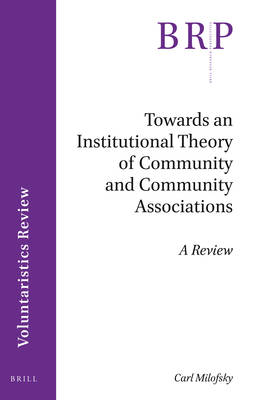
- Afhalen na 1 uur in een winkel met voorraad
- Gratis thuislevering in België vanaf € 30
- Ruim aanbod met 7 miljoen producten
- Afhalen na 1 uur in een winkel met voorraad
- Gratis thuislevering in België vanaf € 30
- Ruim aanbod met 7 miljoen producten
Zoeken
€ 148,45
+ 296 punten
Omschrijving
This article argues the position that the symbolic sense of community is a product of action by associations and larger community-based organizations. It draws on a theory from urban sociology called "the community of limited liability." In the past this theory, first articulated by Morris Janowitz, has mostly been used to argue that residents living in a local neighborhood feel a sense of identification with that area to the extent that the symbolism of that neighborhood has been developed. This article extends Janowitz's theory to apply to local associations and their efforts to create activities, movements, and products that encourage residents to expand their sense of symbolic attachment to a place. We argue that this organizational method has long been used by local associations but it has not been recognized as an organizational theory. Because associations have used this approach over time, communities have a historical legacy of organizing and symbol creating efforts by many local associations. Over time they have competed, collaborated, and together developed a collective vision of place. They also have created a local interorganizational field and this field of interacting associations and organizations is dense with what we call associational social capital. Not all communities have this history of associational activity and associational social capital. Where it does exist, the field becomes an institutionalized feature of the community. This is what we mean by an institutional theory of community.
Specificaties
Betrokkenen
- Auteur(s):
- Uitgeverij:
Inhoud
- Aantal bladzijden:
- 72
- Taal:
- Engels
- Reeks:
- Reeksnummer:
- nr. 17
Eigenschappen
- Productcode (EAN):
- 9789004412606
- Verschijningsdatum:
- 11/07/2019
- Uitvoering:
- Paperback
- Formaat:
- Trade paperback (VS)
- Afmetingen:
- 150 mm x 231 mm
- Gewicht:
- 45 g

Alleen bij Standaard Boekhandel
+ 296 punten op je klantenkaart van Standaard Boekhandel
Beoordelingen
We publiceren alleen reviews die voldoen aan de voorwaarden voor reviews. Bekijk onze voorwaarden voor reviews.








